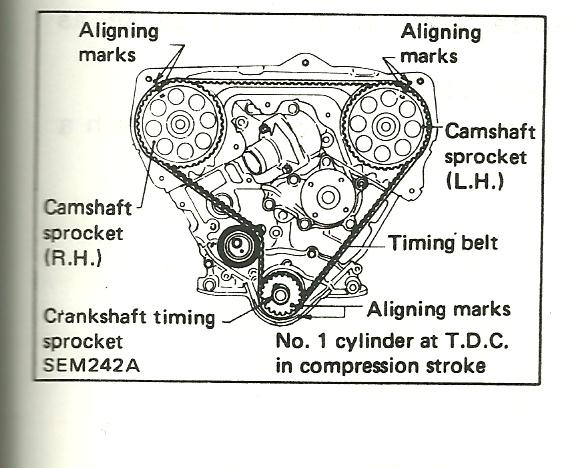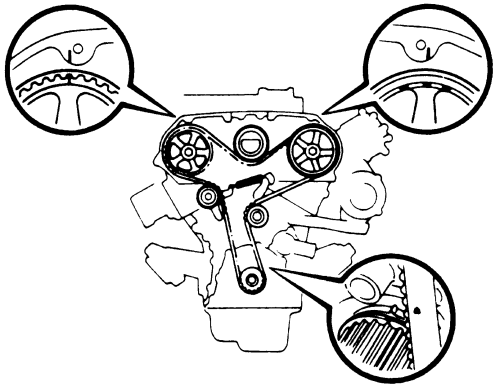The Toyota 4Runner Timing Belt: A Vital Component For Engine Longevity
The Toyota 4Runner Timing Belt: A Vital Component for Engine Longevity
Related Articles: The Toyota 4Runner Timing Belt: A Vital Component for Engine Longevity
Introduction
With great pleasure, we will explore the intriguing topic related to The Toyota 4Runner Timing Belt: A Vital Component for Engine Longevity. Let’s weave interesting information and offer fresh perspectives to the readers.
Table of Content
The Toyota 4Runner Timing Belt: A Vital Component for Engine Longevity

The Toyota 4Runner, a rugged and reliable SUV, boasts a strong reputation for durability and performance. However, like any mechanical system, it relies on critical components to maintain its smooth operation. One such component, the timing belt, plays a vital role in the engine’s precise timing of valve opening and closing, directly impacting engine performance and longevity.
This article delves into the intricacies of the Toyota 4Runner timing belt, exploring its function, importance, replacement intervals, and associated components. Understanding this vital part can help 4Runner owners make informed decisions regarding maintenance and ensure their vehicles run smoothly for years to come.
Understanding the Timing Belt’s Role
The timing belt is a toothed rubber belt that synchronizes the crankshaft and camshaft rotation within the engine. The crankshaft, responsible for turning the pistons, is connected to the camshaft, which controls the opening and closing of the valves that allow air and fuel into the cylinders and exhaust gases out.
The timing belt ensures that these components move in perfect harmony. Each tooth on the belt corresponds to a specific position on the crankshaft and camshaft, ensuring that the valves open and close at precisely the right time for optimal combustion and power output.
The Importance of a Properly Functioning Timing Belt
A properly functioning timing belt is essential for the engine’s health and performance. If the belt breaks or fails, the crankshaft and camshaft will lose synchronization, resulting in:
- Valve damage: Without the timing belt’s control, the valves can collide with the pistons, causing severe damage to both components. This can lead to costly engine repairs or even a complete engine replacement.
- Loss of power and performance: The mistimed valve opening and closing will disrupt the combustion process, resulting in a significant loss of power and fuel efficiency.
- Engine damage: The uncontrolled valve movement can lead to a chain reaction of damage within the engine, including bent connecting rods, damaged pistons, and even a blown head gasket.
Timing Belt Replacement Intervals
The Toyota 4Runner timing belt is designed to last for a certain number of miles or years, depending on the model year and engine type. However, it is essential to follow the manufacturer’s recommended replacement intervals to prevent potential engine damage.
General guidelines for Toyota 4Runner timing belt replacement:
- 100,000 miles or 10 years: This is the general recommendation for most Toyota 4Runner models.
- 120,000 miles or 10 years: Some models, particularly those with the 3.4L V6 engine, may have a longer recommended interval.
It’s crucial to consult the owner’s manual or a qualified mechanic to determine the specific replacement interval for your 4Runner model.
Signs of a Failing Timing Belt
While a timing belt failure can occur suddenly, there are often subtle warning signs that indicate it’s nearing the end of its life. These signs include:
- Unusual engine noises: A clicking, tapping, or rattling sound coming from the engine could indicate a worn or damaged timing belt.
- Loss of power: A noticeable decrease in engine power or acceleration could be a sign of the timing belt slipping or losing its tension.
- Rough idling: The engine may idle unevenly or stall, indicating a timing issue.
- Check engine light: A check engine light illuminated with a code related to timing or valve issues could be a warning sign.
The Timing Belt Kit
When replacing the timing belt, it is essential to replace the entire timing belt kit. This kit includes:
- Timing belt: The primary component responsible for synchronizing the crankshaft and camshaft.
- Tensioner: A device that keeps the timing belt taut, ensuring proper operation.
- Idler pulley: A pulley that guides the timing belt and reduces friction.
- Water pump: While not always included in the kit, it is highly recommended to replace the water pump simultaneously, as it is typically driven by the timing belt and may fail around the same time.
Benefits of Replacing the Timing Belt Kit
Replacing the timing belt kit provides numerous benefits, including:
- Preventing engine damage: Replacing the belt before it fails eliminates the risk of catastrophic engine damage.
- Maintaining engine performance: A new timing belt ensures proper engine timing, resulting in optimal power output and fuel efficiency.
- Peace of mind: Knowing the timing belt is new and functioning properly provides peace of mind and eliminates the worry of potential engine problems.
Tips for Timing Belt Maintenance
- Regular inspections: Have a mechanic inspect the timing belt and its components during routine maintenance checks.
- Follow the manufacturer’s recommendations: Adhere to the recommended replacement intervals for your specific 4Runner model.
- Use genuine parts: Using high-quality timing belt kits from reputable manufacturers ensures optimal performance and longevity.
FAQs
Q: Can I replace the timing belt myself?
A: While some DIY enthusiasts may attempt to replace the timing belt themselves, it is a complex procedure requiring specialized tools and knowledge. It is strongly recommended to have a qualified mechanic perform this task to avoid potential damage or injury.
Q: How much does a timing belt replacement cost?
A: The cost of a timing belt replacement varies depending on the model year, engine type, and labor costs in your area. However, it is generally a significant expense, ranging from $500 to $1500 or more.
Q: What happens if I ignore the timing belt replacement?
A: Ignoring the timing belt replacement can lead to catastrophic engine damage, requiring costly repairs or even a complete engine replacement. This can be much more expensive than replacing the timing belt proactively.
Conclusion
The timing belt is a critical component in the Toyota 4Runner’s engine, ensuring proper valve timing for optimal performance and longevity. By understanding its function, importance, and replacement intervals, 4Runner owners can proactively maintain their vehicles and prevent potentially costly engine problems. Regularly inspecting the belt and replacing it according to manufacturer recommendations can help ensure the smooth operation of your 4Runner for years to come.








Closure
Thus, we hope this article has provided valuable insights into The Toyota 4Runner Timing Belt: A Vital Component for Engine Longevity. We appreciate your attention to our article. See you in our next article!
You may also like
Recent Posts
- The 2025 Toyota 4Runner: A Legacy Reimagined
- The Enduring Appeal Of The Toyota 4Runner Manual Transmission 4×4
- The Toyota 4Runner TRD Off-Road: A Legacy Of Adventure, Reimagined For 2025
- The Anticipation Builds: Unveiling The Next Generation Toyota 4Runner
- The 2025 Toyota 4Runner TRD: A Legacy Of Adventure Reimagined
- The Future Of Color: Exploring The Significance Of Color Trends
- The Toyota 4Runner: A Legacy Of Capability, Now With Expanded Seating
- The Toyota 4Runner Timing Belt: A Vital Component For Engine Longevity
Leave a Reply